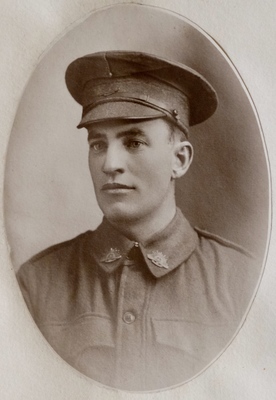A century on from the end of World War I we acknowledge their service …
Lest we forget.
Corporal Robert Ramage
Born: 1887 Pakenham Upper. Died: 7 July 1964 Pakenham.
Enlisted: 3 June 1916 aged 29
Served: Western Front.
Robert was one of James and Janet Ramage’s 10 children. The Ramages, who were described by the Pakenham Gazette as a “grand pioneer family”, were amongst the earliest settlers at Pakenham Upper (then Gembrook South). Robert’s father had been a leading orchardist, as well as a Berwick Shire Councillor and President. Robert attended Pakenham Upper State School, after which he worked for a time at the Toomuc Valley Orchard (TVO) as a fruit case maker.
Prior to enlistment, he was in partnership with Ashley Smart at the “Black Run Orchard”. Robert was 29 when he enlisted on 3 June 1916. He was assigned to the 5th Reinforcement, 8th Machine Gun Company with Povl (Paul) Holdensen, who enlisted at the same time. The two men had consecutive service numbers. A special farewell was arranged at Pakenham Upper for Robert and Paul, as well as George Keable who had enlisted too.
Robert embarked for England on 19 September 1916. After arriving there in November 1916, he was marched into the Australian Machine Gun Training Depot. He subsequently served in a number of key battles on the Western Front: Passchendaele, Polygon Wood, Ypres, Bullecourt, Moilencourt, Sailly-le-Sec and Villers-Bretonneux.
According to the Pakenham Upper State School Honour Book, Robert was wounded on one or two occasions, but “never enough to feature in a casualty list”.
In November 1917 he was promoted to Lance Corporal and to a full corporal in April 1918. In July 1918, het was admitted to hospital sick with conjunctivitis. He was invalided back to the UK and assessed as having a 30 per cent incapacity, which was expected to last for 12 months. On this basis, he was recommended for a discharge as medically unit.
Robert ended the War at the Machine Gun training depot at Parkhouse, England. He embarked for Australia in July 1919 on the HMAT Demosthenes and also on board was Robert’s bride Amy, whom he had met and married in England.
After returning home, Robert purchased Copeland’s orchard in Pakenham Upper. Later, he sold that property and purchased Gar Stevens’ produce store. In the late 1920s, Robert also went into the real estate business.
He was a very community minded citizen. Over the years, he served as a Justice of the Peace, Director of the Pakenham Cool Stores, Trustee of Pakenham Cemetery, Chair of the Pakenham Housing Cooperative and member of the Pakenham Progress Association, local sports clubs and the Masonic Lodge.
Robert took a particularly keen interest local returned servicemen’s activities, including as president of the local RSL sub-branch. During WWII, Robert served his King and country again, this time as a sergeant with the local 11th Battalion, Volunteer Defence Corps. Robert also took a leading role in the Pakenham Repatriation Committee, which assisted some 180 ex-servicemen and women from WWII to re-establish their civilian lives in the district.
After Robert’s death in 1964, the Gazette described him as “one of the most cheery of men”; a “true and loyal friend” and “a general favourite with all who were privileged to know him”.
This is an extract from Patrick Ferry’s book A Century After The Guns Fell Silent – Remembering the Pakenham District’s WWI Diggers 1914-18.
For more details on this and other profiles in the book, head to the website www.pakenhamww1.com







